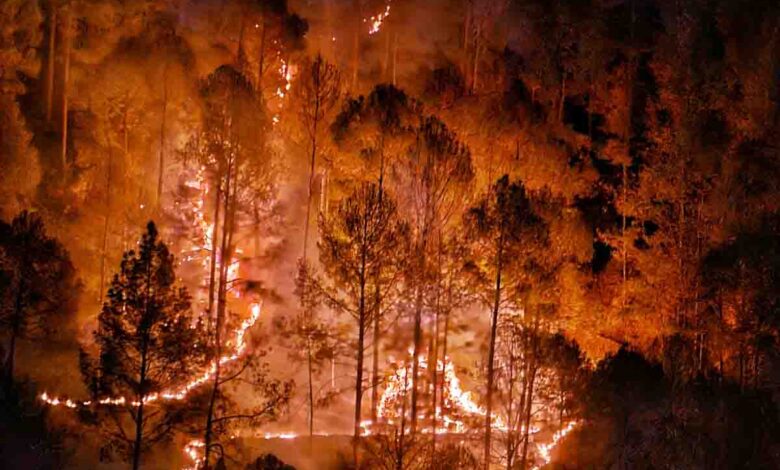The alarming phenomenon of forest fires in Uttarakhand

GUEST COLUMN

“Some say the world will end in fire, some say in ice.”
In these famous lines Robert Frost has imagined the end of the world in fire or ice. Nothing can be said about snow but what is said about fire fits Uttarakhand. People from across the country and abroad are attracted to Uttarakhand due to its unique natural wealth. But for some time now, the State’s natural beauty has been facing serious threats. Life and ecology are in danger due to many natural and man-made disasters. Among these disasters, forest fires is a problem that has been showing its impact consistently for some time. Its intensity is so high across the State that during the fire season, almost the entire governance machinery of the State gets involved in controlling it. According to an estimate, about 63 per cent of fire incidents are man-made, while the remaining 37 per cent are sparked by natural causes. The fact that both of them have in common is that, as a result of both, a terrible disaster comes into existence. Incidents of forest fire have become a cause of concern all over the world. The incidents in California, Amazon and Australia in the past few years are some of the well known examples of this.
At present, while on the one hand the State government is busy facilitating the Char Dham Yatra and attracting tourists and pilgrims, forest fires continue to pose a problem though recent rains have provided relief. The situation got so serious that the help of the IAF’s Mi-17 helicopter had to be taken to extinguish the fire in Nainital and Pauri districts.
In April 2024 alone, a total of more than 600 incidents of fire were recorded. In these reported incidents more than 800 hectares of valuable forest wealth has been destroyed. More than 60 per cent of the fires were recorded in the Kumaon region. About 71 per cent of the total land area in Uttarakhand is forest covered, which shows the richness in biodiversity and that the economy of the State is also directly or indirectly dependent on forests. Therefore, any change taking place in forests has a direct impact on the ecology, environment, economy and above all, the lives of common people. It is noteworthy that earlier, very worrying records of forest fire were recorded in the years 2016 and 2021 as well.
Due to the continuity of fire incidents in Uttarakhand, the time period from February 15 till the end of May is generally considered the fire seasonin which there is a sudden increase in the incidents of forest fires due to dryness in the environment and less rainfall.
Uttarakhand is home to about 700 species of birds and animals, more than half of the bird species in the whole of India are found here. Along with this, the Ganga-Yamuna river system of the State is in the form of a ‘water tower’ for most of the States of north India. The forest fires threaten the existence of living beings and plants. Besides, due to frequent forest fires, natural water sources are consistently drying up, which is creating a water crisis for the large population dependent on them.
Research conducted in 2021 revealed that the quantity of harmful elements like ozone, sulphur dioxide and nitrogen dioxide rises sharply in the atmosphere during the fire season leading to severe health hazards. It is particularly difficult for people suffering from serious respiratory diseases. According to expert SP Sati, “The ash from forest fires blows with the wind and sticks to the glaciers, due to which a layer of black carbon gets deposited on them. Due to this, they absorb heat and start heating rapidly and melting.” Warming glaciers, decreasing forest cover and drying water sources are creating an endless cycle of climate change. This is why the Indian Meteorological Department has recently declared April, 2024 as an unusually hot month.
Given these alarming facts, it is evident that if forest fires occur consistently for three to four months in a year, the entire ecosystem would be negatively affected, the long-term consequences of which are more worrying. Uttarakhand also remains in the news due to frequent landslides during the monsoon once the fire season subsides. It would not be wrong to say that forest fires are indirectly responsible for the landslides. As the trees catch fire and are reduced to ashes, the land gets exposed and its water-holding capacity is destroyed. As a result, a large amount of soil gets washed away with rainwater during the monsoons and causes havoc. Due to past fire incidents, some of the prominent causes of fire have been identified so that lessons can be learned to prevent such incidents in the future. Mainly three factors are responsible for forest fire – heat (conflagration, increase in global temperature, deforestation and construction of concrete forests), fuel (dry wood and leaves, resin) and oxygen.
Since 2016, forest fire has been showing its worst form in the State during the fire season, but even today we seem to be ignorant towards the matter of disaster management and prevention. The main reason for this disappointing situation is the lack of political will and administrative efficiency. Even in the past years, it has been observed that the administration remained hesitant at the decision-making level most of the time because it neither had the experience nor the expertise to deal with such a crisis. The second problem is the ability of the government and administration to tackle the situation. Unfortunately the machinery often becomes active only after such incidents increase to a disastrous level. Instead of a post-disaster response, a solid plan and preparation on part of the administration is very important.
Therefore, there is a need to find quick but far-reaching solutions to stop forest fires. For this, there is a need to divide the strategies into two parts: pre-disaster response and during and post disaster response. On the basis of past data before the disaster, highly sensitive areas should be identified and mapped. The most important step is to empower people at the rural level with resources, power and knowledge. The indigenous knowledge and experience of the local people about that particular area can also be utilised effectively. They should be seen as the solution and not the problem. Along with empowering the Van Panchayats, there is a need to link the local forests with the economy so that people conserve them from the point of view of employment as well.
Pine trees are the biggest cause of fires. Forests comprising large quantities of pine trees are spread over a large area of the State. These forests catch fire two-three times in a single season because these forests are comparatively dry and the temperature fluctuates multiple times. Secondly, the resin (leesa) of pine trees works as fuel for fire. In place of pine trees, broad-leaved perennial trees should be promoted for the region, which not only keep the environment cool and conserve water but are also safe from fire. Awareness can also play a big role as a solution. Awareness programmes should be promoted in schools, colleges, villages and cities. Looking at the situation in Uttarakhand, it can be said that if efforts are not made in time, Robert Frost’s prediction might come true within a hundred years of writing the above-mentioned lines.
(Semwal is head of political science department in HNB Garhwal University, Uniyal is a research scholar; views expressed are personal)






